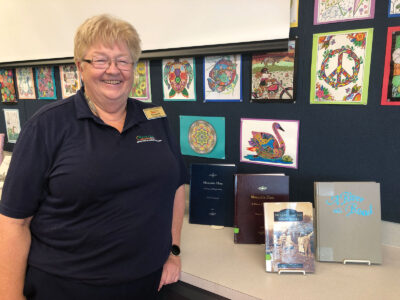By CHERYL JENSEN
The Progress

The history of the early pioneer settlements in Virgin Valley was given by Elspeth Kuta, the Valley Heritage Museum coordinator during a special presentation given at the Mesquite Library branch on Wednesday, October 12. Kuta told stories of the early settlers and their struggles to raise cotton, melons, corn, wheat and cattle to provide for themselves in a desert landscape.
“They came because of the available water and airable land,” said Kuta. “They came with faith and determination to make homes and raise their families.”
Edward Bunker, Sr. and his son, Edward, Jr. lived in Santa Clara and wanted to find a place that they could live the United Order, a religious system, based on accounts in early Christian texts, where everyone in a community agreed to work together and share everything in common.
Members of the Church of Jesus Christ of Latter-day Saints, the Bunker and Leavitt families spent a year working out the laws and rules of the order. They then made plans to divide the property if the order did not work.
Although they were not called by the prophet and leader of the Church, Brigham Young, to settle the area, he advised them to go south of the Virgin River and farm the airable land there.
They left on January 2, 1877, from Santa Clara and traveled several days stopping at Beaver Dam. crossing the river several times along the way, they arrived in the valley.
Thomas Dudley Leavitt, 17 years old at the time, drove the first wagon that entered the valley. “It was always good to be in the first wagon to avoid the dust created by the other wagons,” Kuta related.
The party came with six wagons, 70 head of cattle and about 30 men and boys. Emily Bunker and her two daughters also came. They arrived together on Sunday, January 7.
They quickly built a shanty hut with three sides on the hill south of the river. The foundation with a plaque and marker can still be visited on Riverside Rd. The women slept in the “house” and the men and boys slept outside.
The first priority was to dig irrigation ditches and build a dam in the river so they could plant and get their crops in and growing before the heat of summer. By January 22, they had completed the four-foot-wide canal which ran a mile and a half.
The town of Bunkerville was laid out in ten-acre blocks. Each family had their own land with a house up front and the farm behind.
“How did Bunkerville get its name?” Kuta asked. “Was it because Edward Bunker had the idea and made a plan? Or is the legend true that he and Dudley Leavitt flipped a coin to see what to name it? Bunkerville, it became, but the Leavitts got their revenge because now there are more Leavitts in Bunkerville than Bunkers!”
Bunkerville was the hub of the settlement. It eventually sported a general store, opened by Samuel Crosby. But there was no cash money and he just extended credit. When hard times and people couldn’t pay, bitter feelings ensued and Crosby moved back to St. George.
In 1879 an LDS conference meeting was held in St. George. William Branch, who had pioneered other communities, was asked to come and plant cotton on the north side of the river and start a community. They tried it but it was a tough time. The settlement was not able to grow enough of their own food. Near starvation, they abandoned the area in 1882.
William Elias Abbott came from Bunkerville in 1894 and built a home in Mesquite which is still standing on the corner of Sandhill and Mesquite Blvd. Other families also built homes – Hancocks, Hardys, Waites, and Woodburys.
The town was laid out three blocks x three blocks with one acre each. It was sold at $1.25 an acre. The town was laid out in European style with a town center where the original church was held in a tent 12’ x 12’ (the present site of the splash pad).
The main road, now Mesquite Blvd. was made wide enough so that a wagon could turn around without backing up.
William Branch and Ella had the first child born in Mesquite: a girl named Jane, born on March 6, 1881. This birth was followed by Jack Hardy the first boy born in town in 1895.
Each area in the valley has its own identity in this rural environment. Mesquite continued to grow because the Highway 91 came through town, and much later Interstate 15.
On Wednesday, November 9, at 5:30 pm. the next installment of the local history lecture series will be held at the library. It will talk about the history of homes and infrastructure including electricity and phone service in the Virgin Valley.











1 thought on “Seminar Teaches Early Settlement In Virgin Valley”
Great, read, full of information. looking forward to the next installment